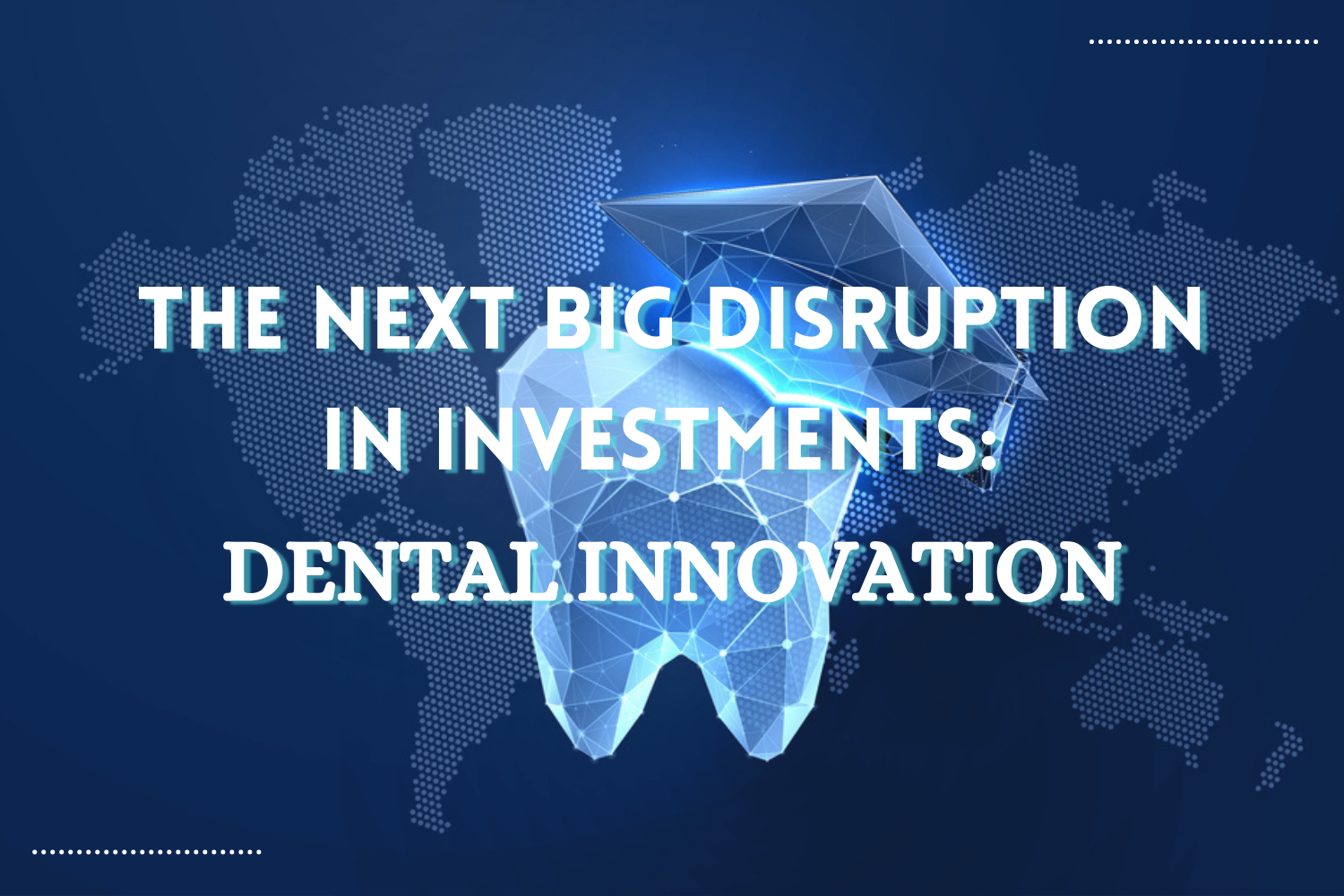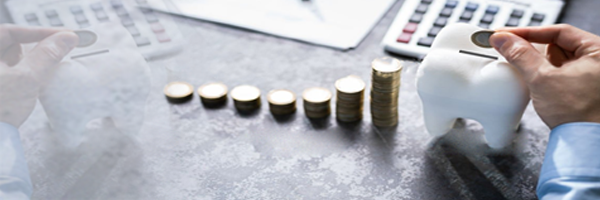
The next big disruption in investments: Dental Innovation
While the dental sector evolved a lot, the idea of dental investments have been constantly overlooked – but, now this gap is creating a major opportunity for the dental investors.

The various sectors and industries that make up the private market have seen a healthy, and sometimes overwhelming influx of capital investment in early-stage enterprises. This trend has fostered a culture that promotes innovation, resulting in an evolution of the industry and a significant increase in productivity. Unfortunately, not all industries have equal access to the capital needed for innovation. Many industries on the verge of turmoil have been overlooked. The confluence of this situation offers excellent investment opportunities.
Dentistry is a technology-oriented profession, and the healthcare sector is heavily influenced by the ubiquitous trends of digitalization. Some of these digital developments can have devastating changes in dental practice, while others have turned out to be just dreams.
Digital transformation of dentistry based on e-Health data is considered to be one of the most important game-changers of the 21st century to address current and future challenges in dental and oral health.
Over the years, we've seen a fair amount of innovation and are ready to see more. Dental DSO companies looking for capital often have to disguise themselves as overly "popular" industries such as technology, artificial intelligence, generic healthcare, and business services to attract the attention of investors.
As a subsector of healthcare, this sector has benefited from increased investment in dentistry throughout the healthcare industry. Investing in healthcare is small compared to other sectors, but it is growing at a considerable pace and has become a staple of the investor portfolio.
There is a driving force for many changes that will last and affect dental practice are as follows:
- The Internet allows promoting the information revolution
- Generational change of values, expectations and norms from Boomers to Millennials
- Technology with artificial intelligence
- Consumer demand for low cost and convenience
- A large amount of venture capital in search of the next big thing
There are also social forces that stimulate the larger medical environment.
- Inability to pay medical expenses. This is reflected in the increase in medical debt and bankruptcy, and the postponement of medical and self-treatment.
- A total class of health care that incapacitates too many people in the face of illness or injury.
- A perception by the public health sector that our health depends more on social, environmental and behavioral determinants than on our healthcare system and its physicians.
Knowledge of cyclical and structural trends and past investor experience helps shape expectations for future performance. Combining the intuition of industry experts with the results of data-driven analysis gives you a detailed understanding of dentistry and investment. That's what every venture capitalist in the dental industry should do.
How COVID 19 has hit the dental healthcare sector?
Needless to say, the pandemic has influenced all courses of life, including the dental office. Recently, the Health Policy Institute (HPI) surveyed the economic impact of COVID19 and tracked weekly reports on PPE supply, patient traffic, dental staff payment status, etc. by 2021.

The last poll has revealed the following stats:
Patient flow in personal practice has been stable for several months, at 90% of pre-COVID 19 levels in December 2021.
The incidence of patients was highest among dentists under 35 years (96%) and 35-45 (94%).One in four owner-run dentists charged a fee in the last month of 2021 to maintain financial viability. This was the most common fiscal sustainability action that took place throughout 2021.
Borrowing was common in early 2021, probably due to the timing of federal support programs. A variant of COVID19 Omicron may have influenced some dentists' outlook for recovery from a pandemic.
Confidence levels declined, dropping from 75% of dentists who said they were very or somewhat confident in the recovery of dental practice last month to 71% in December 2021.
Expense hit
National dental spending in 2020 was hit by an increase in pandemic. Overall, there was a 1.8% decline in the dental industry in 2020.
Sound outlook
As we move through the era of COVID, prospects look promising for both patients and dental practice as dentists continue to see patients and find wise ways to stay alive.
Dentistry has long been actively involved in improving products and services for the core high-end patient market through expensive new technologies, materials, technologies and payment arrangements. These start in the luxury market and permeate the entire dental market and the recent pandemic has only reshaped it.
Technologies such as computer-assisted design and manufacturing, lasers, and older transitions (e.g. from foot pedals and motor-driven belt handpieces to high-speed pneumatic devices) are becoming pervasive in dentistry and can be quite costly.
Similarly, new dental materials that have launched an adhesive revolution and improved aesthetic dentistry, new technologies such as dental implants and high-tech endodontics that leave more teeth in high-income earners than low-income earners, and make them better.
Dental insurance payment arrangements continued and all paid jobs followed the same high and low routes to dental practice.
Healthcare reform discussions usually focus on the progress the industry is making against the mandated number-lowering the proportion of uninsured, increasing productivity and improving indicators related to new ones. These high-level measurements are important for performance tracking, distracting you from understanding the true causal mechanisms that make the industry more affordable and accessible.
The resilience of the dental sector in an era of economic uncertainty
One of the best aspects of the dental industry is performed during a recession. In this case, demand is significantly reduced, significantly hampering most companies' ability to generate profits and reach break-even points.

Industry experts with huge investments claim that the dental industry is resilient to recessions and support their claims by providing strong anecdotal evidence from past recessions. The data support this claim. The tendency to seek dental care for adults is only affected if wealth is reduced by more than 50%. The data show that dental insurance claims (and therefore dental income) increase significantly during a recession. This surge occurs when people rush to serve in anticipation of a disruption in coverage.
Understanding how dental investment dentistry works in different economic environments is always important, but this topic is especially important today as it faces significant uncertainties due to the ongoing pandemic. Early results on the resilience of the dental industry encourage the inclusion of early-stage dental DSO companies in their investment portfolio. Other factors strengthen the belief in choosing an oral health venture fund like a Libyan partner.
Looking at the bottom of today's dental healthcare market, we see several disruptive innovations that are important to the future of dentistry and work in almost the opposite direction, from the low to the high social aspects of the dental industry. These can be categorized as a four-level hierarchy, the first level is already clearly identifiable, and the higher levels are evolving.
Tier 1:
Dental Disruption includes efforts to unify practices and improve the efficiency of business operations.
Today, these are reflected in the decline of single and small partnership practices and the rise of dental support organizations (DSOs).
As early as 1986, Lipscomb and Douglas discovered that group practices were more efficient and reduced overhead. They also wondered if these apparent production efficiencies would eventually be converted by the market into lower prices, shorter queues, or other non-price profits.
The answer was clearly "NO". Instead of benefiting patients, these efficiencies benefit many companies that have set up and provided business services to dental companies of unprecedented size.
Tier 2:
Dental turmoil occurs when innovators fill market gaps where mainstream dentists recognize or don't care about unmet demand. A prime example was the high demand for oral care from families with targeted children (low-end market). Low-income parents face the serious challenge of finding a dentist participating in Medicaid to enroll their child.
In doing so, they sometimes faced barriers to transportation, language and culture, which frustrated them. DSO has entered the market with a Medicaid only pediatric dental practice model that operates efficiently, provides high volume treatment, is profitable and provides convenience for low-income consumers.
As of 2009, an estimated 21% of the 13 million Medicaid-enrolled children who visited the dentist's office were treated with one of the DSOs of children in these Medicaids. Consistent with the theory of disruptive innovation, this innovation has since affected general dentistry and increased the proportion of pediatric dentists actively participating in public insurance.
Tier 3:
Dental turmoil aims to change the very structure that characterizes dentistry by changing key elements of the dental system. Tier 3 innovators no longer mess with edges (like Tier 1 and Tier 2), but if dentistry on the road isn't supposed to work for patients, what can do a better job yet, we’re asking if it works.
This often begins at the low end of the market, as evidenced by the emergence of dental therapists who have been approved by the Legislature as a solution to unfair access and sometimes seek to limit their use on safety nets. Other examples that provide convenience, payer cost-effectiveness, or estimated consumer value are remote dentistry for home-based and poorly serviced groups, employer-side dental services, and shopping.
The mall's beauty kiosk, and perhaps the one that will most impact future models of Dentistry-an extension of pay-for-performance, will be an alternative payment mechanism (APM) to pay service fees.
Already apparent in medicine, APM seeks to secure value by balancing health outcomes with costs. These range from FFS related to quality and value to APMs that share savings and monetary risks, and population-based payments that blur the line between insurers and the medical system.
Tier 4:
Dental confusion is public health by attempting to change the content of oral care by encouraging professionals to address the social, behavioural and environmental determinants of oral hygiene, as well as the practice of traditional dental treatment. We make great use of this principle. These principles include allocating scarce resources to those in need, prioritizing prevention and disease management, considering the full range of health determinants, and providing care in the context of family and community.
Each continuous level of dental innovation improves our patients and their dental value proposition for those who aspire to be patients.
Disruptive innovation shapes the field of medical systems science. It aims to increase the value, quality and safety of health care while promoting better health outcomes at the population level. With the rapid changes in the US medical system, it is time to integrate this expanding science, along with biomedicine and clinical science, into dental education from the first day of dental school to the final day of dental school.
As we define, turmoil doesn't necessarily mean that startups beat industry giants, making products and services much more affordable, transforming the industry, and living a growing population.

It examines the role of confusion in dealing with the two tragedies of rising costs and quality inequality and provides a solution consisting of three key components.
Enable Technology:
Inventions or innovations that make a product or service available to more people at a more affordable price
Innovative Business Model:
How to target non-consumers (those who have never previously purchased a particular product or service) or low-end consumers (the least profitable customers). This is easiest for beginners as it is not tied to existing models.
Value Network:
A commercial infrastructure that favors partners, distributors, and customers as disruptive innovation surges
The US Bureau of Labor Statistics reports that the demand for dental services will increase as the population ages and more studies link oral health to overall health. This will increase the number of dentists hired from 2019 to 2029 by 3%.
In addition, the Biden administration plans to expand the Affordable Care Act to increase access to health care for uninsured people. This means that more people are going through the doors of the dental office. This boosts patients during a recession.
Dental Healthcare Venture Capital Investment Strategy
It is not surprising that dental investment in the medical technology sector is particularly lucrative, as the alternative medicine and provider businesses are growing significantly.
Silicon Valley Bank, one of the largest players in the healthcare venture capital funding market, reported that dental healthcare venture capital funding in the United States reached a record USD 10.7 billion in 2019. Not surprisingly, venture investments in the health technology space are particularly lucrative. The alternative care and provider business is growing significantly.
Getting 3rd Party investments
This means that external investors are required to develop and execute venture capital programs for businesses. They are looking for innovations that can be tested, improved and scaled to do all the work and bring it to market. They often do this by creating a simulation beta environment and consumer tests.
Consider the in-house potential
Many organizations are looking for dental investment opportunities. For example, create a technology wing to test innovations such as 3D printing and augmented reality. This type of strategy fits well with long-term goals, especially if you want to partner with vendors, researchers and venture capitalists like Dentist Innovation Fund.
Conclusion
Many of the changes taking place in dentistry today reflect the larger medical environment in the United States and are entering dentistry from the bottom of the market, which has a more disruptive impact on traditional healthcare models than ever before. Possible changes will affect where and how care is provided and how you pay your dentist. The dentist needs to be aware of these changes and be prepared for them.
The Dental Innovation Fund is working with organizations that are just beginning their growth journey to find the best companies to improve their dental offerings.
Strategy and innovation practices of the Dental Innovation Fund help organizations design and shape the future, rather than disrupting it. As a leader in disruptive innovation and strategic transformation, Dentist Innovation Funds works with clients in a variety of industries to identify new growth opportunities, build new ventures and capabilities, and accelerate organizational transformation.
To learn more about the Dental Innovation Fund, reach out to us at contact@dentalinnovation.fund or visit our website https://dentalinnovation.fund/